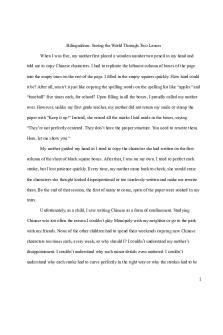Sample Literacy Narrative PDF

| Title | Sample Literacy Narrative |
|---|---|
| Author | Steven Shi |
| Course | Writing and Critical Reasoning–Thematic Approaches |
| Institution | University of Southern California |
| Pages | 5 |
| File Size | 83.2 KB |
| File Type | |
| Total Downloads | 52 |
| Total Views | 142 |
Summary
Download Sample Literacy Narrative PDF
Description
Bilingualism: Seeing the World Through Two Lenses When I was five, my mother first placed a wooden number two pencil in my hand and told me to copy Chinese characters. I had to replicate the leftmost column of boxes of the page into the empty ones on the rest of the page. I filled in the empty squares quickly. How hard could it be? After all, wasn’t it just like copying the spelling words on the spelling list like “apples” and “baseball” five times each, for school? Upon filling in all the boxes, I proudly called my mother over. However, unlike my first grade teacher, my mother did not return my smile or stamp the paper with “Keep it up!” Instead, she erased all the marks I had made in the boxes, saying “They’re not perfectly centered. They don’t have the proper structure. You need to rewrite them. Here, let me show you.” My mother guided my hand as I tried to copy the character she had written on the first column of the sheet of black square boxes. After that, I was on my own. I tried to perfect each stroke, but I lost patience quickly. Every time, my mother came back to check, she would erase the characters she thought looked disproportional or too carelessly written and make me rewrite them. By the end of that session, the first of many to come, spots of the paper were soaked in my tears. Unfortunately, as a child, I saw writing Chinese as a form of confinement. Studying Chinese was too often the reason I couldn’t play Monopoly with my neighbor or go to the park with my friends. None of the other children had to spend their weekends copying new Chinese characters ten times each, every week, so why should I? I couldn’t understand my mother’s disappointment. I couldn’t understand why such minor details even mattered. I couldn’t understand why each stroke had to curve perfectly in the right way or why the strokes had to be
1
written in a very specific order. The order of the “right” way just wasn’t efficient. Each stroke had to be a smooth, continuous motion that had to begin from the left or the top. For a character as simple as “口”, the word for mouth or opening, I couldn’t just draw a square without lifting the pencil from the paper. “口” consisted of three strokes. The first consisted of the left side of the square; the second the top side and the right side in one continuous motion, and the last the side which completes the box. To my five-year-old self, this was all so unnecessarily arduous of a task but it was a task that taught me to see writing as a form of art. Writing Chinese required me to paying close attention to the details of writing I never thought twice about when I studied English spelling lists for vocabulary tests at school. As I improved, I realized I could could express myself in Chinese just as well as I could express myself in English. I could use Chinese to write about the first time I boarded an airplane or the apricot tree my grandfather had planted from a seed. Soon, I began to write short narratives in Chinese, a few of which made their way into issues of the People’s Daily Overseas Edition, a Chinese newspaper. I also competed in Chinese speech contests and Chinese poetry recital competitions. By then, Chinese was such a big part of my life, it became an inextricable part of me. I could no longer hate it. As I grew older, I gradually became more appreciative of writing those characters. I began to closely examine the pictographs and ideographs as I wrote them, and the origins of certain words became fascinating. For instance, I realized that the character for “sharp” (尖) consists of the character representing the character for “small” (小) stacked atop of the character for “big” (大) because a sharp object has a small end and a much wider end. The phrase for “forest” (森林) is made up of multiple copies of the character for “wood” (木). The character for
2
“prisoner” (囚) consists of the character for person (人) enclosed within a box. I began to pay attention to how the smaller individual characters could work together to function as a bigger whole. Writing these characters slowly helped me understand the values of a collectivist culture-the characters were symbolic of individuals functioning together as a body in society. This was an idea many of my monolingual peers did not explore until high school Advanced Placement Literature class, when they analyzed John Donne’s statement “No man is an island, entire of itself.” Undoubtedly, those who do not have the advantage of being multilingual often miss out on the chance to pick up many values and perspectives early on. Apart from the structure of words, the Chinese language is also different from the English language because it stresses familial relationships. There is no character or phrase that is the equivalent to the term “grandparents.” Instead, one refers to each grandparent individually. The words for paternal grandfather (爷爷), paternal grandmother (奶奶), maternal grandfather (外公), and maternal grandfather (外婆) are all distinct and emphasize the speaker’s relationship to each grandparent. Similarly, at a Chinese extended family reunion, one would not hear “Aunt Linda” and “Uncle Bob.” Instead the greetings would specify the birth order of the relative, whether the relative is from the maternal or paternal side of your family, and whether the relative was married into your family. Rather than subconsciously categorizing relatives into large groups like “grandparent,” “aunt,” or “uncle, ” I was programmed by the language to understand my relation to each member of my extended family and to give each family member a special place in my mind and heart. Learning a second language not only allowed me to build deeper relationships within my extended family but also taught me to value each family member, opportunities my monolingual English-speaking counterparts often did not have. --------------------------------------------------------------------------------------------------------------------3
Language shapes thinking. There are ideas captured by the words of one language that can’t be truly expressed in any other. For example, cultures with distinct names for different shades of blue can see more shades of blue than can cultures that lump all shades of blue into a single term like “blue.” When you’re a native speaker, language connects you to others because of common understanding. With two mother tongues, I was taught to see the world through two different lenses--the traditional, collectivist, orderly lens of the Chinese household I grew up in, and the young, individualist, spontaneous lens of the American I aspired to be. Learning a second language as a child not only taught me the importance of society and family but also shaped me into the open-minded bilingual I am today. Although I dreaded writing and rewriting characters twelve years ago, I can’t tell you how grateful I am for the opportunity to learn a second language as a child. There are so many profound lessons and values a second language can offer that we should provide all children with an equal opportunity to learn them. Appropriately, we should begin exposing young children to multiple languages by implementing a multilingual education program starting in preschools and elementary schools. Although it is never too late to start learning a new language, studies have shown that the best time to learn a second language is when the brain is rapidly developing and that learning multiple languages increases flexibility, creativity, and critical thinking skills in young children. Of course, the countless benefits of multilingualism extend long past childhood and even include preventing cognitive decline among older adults. However, there are more advantages to learning an additional language at a younger age. When a young child learns multiple languages simultaneously, he or she learns to think in terms of each language rather than to think in terms of one language. Learning a new language long after mastering one’s first language (as with learning a new language in middle school or high school) usually means learning and
4
understanding the new language in the context of a first language, where the speaker would tend towards translating an idea from his or her native language to the second language before speaking or writing. As a result, offering foreign language courses starting in middle school or high school is not as effective as teaching new languages to children in preschool or kindergarten because it does not provide students with the same multilingual experiences. With multilingual education implemented beginning in preschools and elementary schools all over the country, the future population of the United States would doubtlessly be more well-equipped to improve international relations and address global issues. From becoming a more capable and open-minded citizen to simply seeing concepts or colors present only in certain languages, many children as well as society as a whole can benefit from a system of early multilingual education. I am only one of many people who are familiar with the advantages of earning multiple languages as a child. The young child crying over rewriting the characters in her second language finally opened her eyes to see a beautiful new world the new language brought to her. (Word count: 1543)
5...
Similar Free PDFs

Sample Literacy Narrative
- 5 Pages

Literacy Narrative
- 5 Pages

Literacy Narrative - Grade: n/a
- 5 Pages

Narrative Sample charter
- 4 Pages

Sample narrative note
- 2 Pages

Computer literacy
- 5 Pages

Literacy Assessment
- 1 Pages

health literacy
- 16 Pages

Literacy Autobiography
- 2 Pages

NARRATIVE REPORT
- 1 Pages
Popular Institutions
- Tinajero National High School - Annex
- Politeknik Caltex Riau
- Yokohama City University
- SGT University
- University of Al-Qadisiyah
- Divine Word College of Vigan
- Techniek College Rotterdam
- Universidade de Santiago
- Universiti Teknologi MARA Cawangan Johor Kampus Pasir Gudang
- Poltekkes Kemenkes Yogyakarta
- Baguio City National High School
- Colegio san marcos
- preparatoria uno
- Centro de Bachillerato Tecnológico Industrial y de Servicios No. 107
- Dalian Maritime University
- Quang Trung Secondary School
- Colegio Tecnológico en Informática
- Corporación Regional de Educación Superior
- Grupo CEDVA
- Dar Al Uloom University
- Centro de Estudios Preuniversitarios de la Universidad Nacional de Ingeniería
- 上智大学
- Aakash International School, Nuna Majara
- San Felipe Neri Catholic School
- Kang Chiao International School - New Taipei City
- Misamis Occidental National High School
- Institución Educativa Escuela Normal Juan Ladrilleros
- Kolehiyo ng Pantukan
- Batanes State College
- Instituto Continental
- Sekolah Menengah Kejuruan Kesehatan Kaltara (Tarakan)
- Colegio de La Inmaculada Concepcion - Cebu





